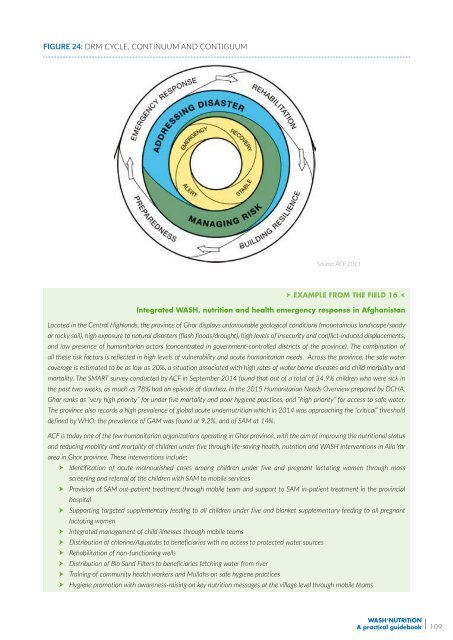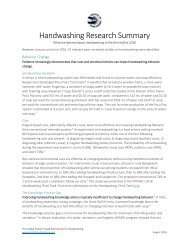WASH’ Nutrition
manuel_wash_nutrition_online
manuel_wash_nutrition_online
Create successful ePaper yourself
Turn your PDF publications into a flip-book with our unique Google optimized e-Paper software.
Figure 24: DRM cycle, continuum and contiguum<br />
Source: ACF 2011<br />
EXAMPLE FROM THE FIELD 16 <br />
Integrated WASH, nutrition and health emergency response in Afghanistan<br />
Located in the Central Highlands, the province of Ghor displays unfavourable geological conditions (mountainous landscape/sandy<br />
or rocky soil), high exposure to natural disasters (flash floods/drought), high levels of insecurity and conflict-induced displacements,<br />
and low presence of humanitarian actors (concentrated in government-controlled districts of the province). The combination of<br />
all these risk factors is reflected in high levels of vulnerability and acute humanitarian needs. Across the province, the safe water<br />
coverage is estimated to be as low as 20%, a situation associated with high rates of water borne diseases and child morbidity and<br />
mortality. The SMART survey conducted by ACF in September 2014 found that out of a total of 34.9% children who were sick in<br />
the past two weeks, as much as 78% had an episode of diarrhea. In the 2015 Humanitarian Needs Overview prepared by OCHA,<br />
Ghor ranks as “very high priority” for under five mortality and poor hygiene practices, and “high priority” for access to safe water.<br />
The province also records a high prevalence of global acute undernutrition which in 2014 was approaching the “critical” threshold<br />
defined by WHO: the prevalence of GAM was found at 9.2%, and of SAM at 14%.<br />
ACF is today one of the few humanitarian organizations operating in Ghor province, with the aim of improving the nutritional status<br />
and reducing mobility and mortality of children under five through life-saving health, nutrition and WASH interventions in Alla Yar<br />
area in Ghor province. These interventions include:<br />
Identification of acute malnourished cases among children under five and pregnant lactating women through mass<br />
screening and referral of the children with SAM to mobile services<br />
Provision of SAM out-patient treatment through mobile team and support to SAM in-patient treatment in the provincial<br />
hospital<br />
Supporting targeted supplementary feeding to all children under five and blanket supplementary feeding to all pregnant<br />
lactating women<br />
Integrated management of child illnesses through mobile teams<br />
Distribution of chlorine/Aquatabs to beneficiaries with no access to protected water sources<br />
Rehabilitation of non-functioning wells<br />
Distribution of Bio Sand Filters to beneficiaries fetching water from river<br />
Training of community health workers and Mullahs on safe hygiene practices<br />
Hygiene promotion with awareness-raising on key nutrition messages at the village level through mobile teams<br />
<strong>WASH’</strong><strong>Nutrition</strong><br />
A practical guidebook<br />
109



